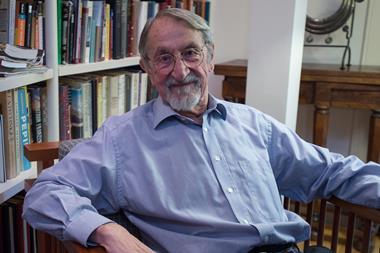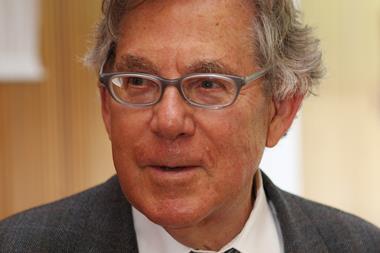
Biochemist Paul Berg, who shared the Nobel Prize in chemistry in 1980 for his contributions to basic research involving nucleic acids and is often referred to as the founder of genetic engineering, has died at the age of 96. Born in the US to Jewish immigrants from Russia, Berg was the first to introduce DNA from one organism into another. He was also a founding member of Stanford University’s biochemistry department, serving as an emeritus professor there until his death on 15 February at his on-campus home in California.
Berg is renowned for techniques he developed to splice and join DNA, which helped spawn recombinant DNA technology and the field of biotechnology. He published over 200 scientific articles throughout his career, retiring from research in 2000. Concerns about the potential impact of recombinant DNA led Berg to join calls for a pre-emptive, voluntary moratorium on genetic engineering studies in 1974.
After earning his undergraduate degree in biochemistry from Pennsylvania State University in 1948, he received a PhD in biochemistry from Case Western Reserve University in Ohio in 1952, followed by a two-year postdoctoral fellowship at the American Cancer Society. He then became a professor at Washington University School of Medicine in St Louis between 1955 and 1959, before settling at Stanford.
‘Paul’s legendary research contributions and leadership changed the trajectory of biomedical research. His boundless curiosity, enthusiasm for science, visionary thinking, and deep interest in and support of trainees set the joyful esprit de corps that has permeated the department for decades,’ said Mark Krasnow, who holds a biochemistry professorship at Stanford named after Berg and his wife Mildred, who passed away in 2021. ‘It spurred the impactful science and careers of our thousand trainees and colleagues, including me,’ Krasnow added.
Berg chaired Stanford’s biochemistry department from 1969 to 1974, and championed the construction of the Beckman Center for Molecular and Genetic Medicine on the university’s campus, raising more than $50 million (£41 million) for the building that opened in 1989. Berg led the centre until 2000.
Didn’t suffer fools
‘Paul didn’t suffer fools,’ recounted Christopher Scott, research staff emeritus of biomedical ethics whom Berg supervised as director of the Beckman centre. ‘He could be a real tough guy, but he was always in service of a higher calling, whether it be fundraising, pushing a scientific idea forward or recruiting some of the best talent the world had to offer to Stanford,’ added Scott, who is currently a clinical ethics and health policy professor at Baylor College of Medicine in Texas.
‘There has arguably not been a faculty member in Stanford Medicine’s long history who was more dedicated to developing student researchers,’ added PJ Utz, an immunology and rheumatology professor at Stanford. ‘It did not matter to Paul whether medical students generated new knowledge in the basic, translational, clinical, physical or social sciences. Research and advancing medicine are what mattered to Paul.’
‘The fundamental principles of cutting DNA with restriction enzymes and pasting them together with DNA ligase revolutionised the way everyone in the field of molecular biology conducts experiments,’ said Paul Babitzke, a biochemistry and molecular biology professor at Penn State, of the recombinant DNA technology developed in Berg’s laboratory in the 1970s.
Penn State chemistry chair Stephen Benkovic said Berg had had ‘an enormous impact in a number of areas’. In particular, Benkovic described how every time his lab takes a plasmid, introduces it into a bacterium and produces a protein, that procedure is directly attributable to Berg’s original insights. ‘This technique is done all over the world and has allowed us to greatly understand many aspects of biochemistry, and in my own case, enzymology.’
Besides the chemistry Noble prize, Berg also won the Lasker Award in Basic Science in 1980 for cloning genes, and the National Library of Medicine Medal for ‘historic achievements which helped to make recombinant DNA a brilliant reality’. A few years later, President Ronald Reagan also awarded him the National Medal of Science for ‘fundamental contributions to understanding the mechanisms of gene expression, for the development of recombinant DNA and for a deep concern for its safe and humane application to medicine’.
Among the greats
‘Paul was one of the greatest 20th century biochemists who founded @StanfordBiochem,’ tweeted Aaron Straight, chair of biochemistry and professor of chemical and systems biology at Stanford. ‘He was a friend and mentor who I will miss dearly. His passion and advocacy for science and education was infectious.’
Berg disputed descriptions of himself as the ‘father of genetic engineering’, however, in an interview in 2001. ‘In fact, we made only the first step and everybody else seized immediately on this new technology, new capability and began to use it for their own purposes, which is what it was intended to do.’
Berg also expressed some concern that universities have become too commercialised over time. ‘I think my university – Stanford University – is probably one of the leaders, in large part because it made a lot of money very early from the patents on recombinant DNA,’ he added. Berg estimated that Stanford probably earned more than $100 million over the course of 17 years from these patents.
‘So other universities see that as a possible way of earning money, so they have become much more aggressive about seeking patents,’ he added. ‘Whereas before, when I was growing up in university, nobody ever asked me to patent anything, and I never patented anything in my life – I gave away everything I ever did because what we did it for was to benefit research.’

















No comments yet